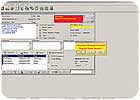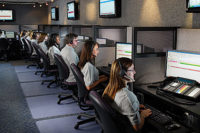
When alarm signals come in to a central monitoring station, it’s critical that central station operators handle those signals speedily and accurately. Central station automation software is the single greatest factor determining operators’ ability to meet that requirement.
Today’s sophisticated central station automation software systems offer unprecedented flexibility and efficiency. Even more importantly, they have many built-in features that eliminate the need for operator guesswork or judgment calls, saving extra steps for the operator and helping the operator process signals more promptly and with a higher degree of accuracy.

Some central station software, such as GE’s product used by Vector Security, sends information about a specific alarm to a specific operator based on the operator’s skill level and availability.
FIRST STEPS
To see how today’s systems work and their benefits, let’s look at the steps that occur when an alarm signal comes in to a central station.With virtually all systems, signals are prioritized depending on the type of alarm. Fire alarms get the highest priority, followed by hold-up and burglary — in that order. Lower-priority signals typically include low-battery or exception reports, such as “failed-to-open” or “failed-to-close” signals, which alert the central station when the alarm system at a commercial account is not armed or disarmed according to a pre-assigned schedule. Sensor monitoring alarms may be assigned a relatively high or relatively low priority, depending on the specific application. For example, sensors monitoring tanks storing dangerous chemicals would likely have a higher priority than the refrigerator in a vacation home.
How an alarm gets to a particular central station operator varies depending on the automation software used. Some systems, such as the GE Security system used by Pittsburgh-based dealer Vector Security, send information about a specific alarm to a specific operator based on the operator’s skill level and availability, with high-priority alarms being routed ahead of lower-priority alarms. Each operator only sees information pertinent to a specific alarm, including the customer name, address, account number and other information, notes Vector Security vice president, Anita Ostrowski.
Other systems, such as the Manitou system from Bold Technologies that is used by Alert Alarm of Honolulu, display a list of alarms — color-coded by priority level — on a common screen that can be seen on each operator’s monitor. Any operator who is available to handle an alarm selects the highest-priority alarm and begins to process it. That approach works well for Alert Alarm, which has a policy of sending all alarms to a supervisor after the operator has taken preliminary actions, such as calling the premises and/or some people on the customer’s call list. At that point, Alert Alarm vice president Antoinette Boilard explains, “the operator passes the call to the supervisor who reviews the data and determines whether to call the police.”
The steps that a central station operator takes in handling an alarm depend on the type of alarm, local regulations, an individual central station’s policies, and the specific instructions provided by the home or business owner. For fire and hold-up alarms, however, the first step is always the same: call the authorities. After fire or police have been called, the central station operator then notifies the customer or someone on the customer’s call list what has happened.

The steps that a central station operator takes in handling an alarm depend on the type of alarm, local regulations, an individual central station’s policies, and the specific instructions provided by the home or business owner.
HANDLING BURGLAR ALARMS
For burglar alarms, however, the first step usually is not to call the police. Instead, the central station operator typically will call the premises and if someone answers, will ask for a pass code. Typically if the person cannot provide a pass code, the police are called.Often, however, the central station operator gets no answer at the premises. In that situation, the central station often will try to reach the customer at a different number, such as a cell phone, or will call people on the customer’s contact list. If the operator reaches someone, he or she will explain that a burglary signal has been received and will ask whether to dispatch police.
Other information on the operator’s screen also can help in differentiating between a false alarm and a real burglary. Information about which zones have been tripped is one example. “If a motion detector goes off and you know they have more protection, more should be happening,” Boilard notes. “If nothing else was tripped, it’s usually a false alarm and we would try to call the customer. If a motion and a door and other zones are reporting alarm signals, we try to immediately call the police.”
Ostrowski offers another example. “If the system was just armed and then we got a burglary signal, we definitely make sure we’re calling the owner’s cell phone.” The reason, of course, is that in that situation, there is a strong likelihood that the customer overlooked an open door or made some other type of error when arming the system.
A customer’s alarm history, which some systems display on the operator’s screen, also can be helpful. “We have a two-hour no-dispatch rule,” Ostrowski notes. If the 24-hour history window on the operator’s screen shows that an account has had an alarm within the past two hours, the operator will notify the customer or another contact. But if the police were previously called, the central station will not call them again unless at least two hours have passed.
A small but growing number of central stations also have the ability to use a video link to the customer site to help determine whether an alarm is real or false. (See related story, “Video and Access Control Integration Can Provide an Edge,” on page 82.) Neither Alert Alarm nor Vector Security have implemented that capability as of yet. But it is likely to increase in popularity in the future because some municipalities have passed ordinances to prevent police from responding to a burglary alarm unless an actual burglary has been verified. In those locations, home and business owners may have no choice other than to use video verification or to hire a private guard service to respond to alarms.

Bold Technologies’ central station automation software, Manitou, integrates with several manufacturers’ video surveillance products.
RECORD-KEEPING
Most central station automation software provides the ability to put an account that has reported an alarm on hold. This would typically occur, if for example, operators were unable to reach the customer or anyone on the customer’s call list. After dispatching police, an operator might put the alarm on hold so that he or she (or another operator) could try the customer contacts again later until someone could be reached and notified of the alarm. With the Manitou system that Alert Alarm uses, calls that are on hold remain on the master screen so that an available operator can select them and handle the follow up.Vector uses a separate queue and a separate pool of operators to handle alarms that have passed the critical police dispatch phase, but still require customer notification. Ostrowski calls it a “second response queue” and notes that recently hired central station operators are assigned to the second response queue for their first three months or so on the job.
Clearly, responding to an alarm, particularly a burglar alarm, is not a cut-and-dried process. Some systems rely on a paragraph or two of explanatory text that appears on the screen for each account, while others attempt to add a level of automation to the process by, for example, presenting operators with a series of screens instructing them exactly what to do next. The order in which those screens appear may be based on central station policies or on instructions provided by each individual customer.
Whatever steps an operator takes, it is also critical to record them for law enforcement and insurance purposes. Here, too, some systems offer a certain level of goof-proofing. When a Vector operator calls the customer premises, Ostrowski notes, the GE Security software essentially forces the operator to provide a description of the call. Ostrowski adds that Vector maintains all of its alarm records electronically, rather than on paper.
Alert Alarm also stores alarm information electronically, but keeps paper records, as well.

MicroKey Software’s central station automation software has the ability to integrate with the company’s management modules for a complete solution.
NEW COMMUNICATIONS OPTIONS
Other important developments in central station automation software stem from modern communications technology, which is changing how central stations interface with home and business owners. Several central station software suppliers offer the ability to automatically send the customer an e-mail or cellular text message in the event of an alarm.Increasingly, central station software suppliers also are integrating their systems with access control systems, creating new benefits for the customer and new revenue streams for the central station. (See related story, “Video and Access Control Integration Can Provide an Edge,” on page 82.)
Sidebar: Video and Access Control Integration Can Provide an Edge
One of the biggest trends in the security industry in recent years is integration. Increasingly, security dealers are installing systems that integrate intrusion protection with video surveillance, access control or both.The technology — hardware and software — starts at the customer premises and extends into the central station. More and more central stations are adding the systems needed to to monitor video and access control as well as alarm systems for their customers, and to do so in a seamless manner.
Although the ability to remotely monitor access control systems has been around for some time, stand-alone systems of the past often created problems for central station operators, as Wayne Torrens, president of Kissimmee, Fla.-based central station supplier MicroKey Software, vividly describes. Noting that each operator typically sits in front of his or her own terminal, Torrens says, “Once in a while the Mac in the corner would beep and someone would have to go deal with it rather than the computer terminal they normally deal with. It was the access control monitoring system indicating that a door was propped open. And someone had to get up and handle it. But only two people were trained on it. One of them was Sally, but Sally’s talking to some police department. It became a big nightmare.”
To make such monitoring more efficient, some manufacturers have integrated access control and video surveillance monitoring with their central station automation software so that all three types of alarms can be handled through the same interface. Typically, such systems also offer a single activity log for each customer that encompasses alarm reports from all three types of systems. It’s important to note, though, that some development work is required to enable specific manufacturers’ products to work together. Central station software suppliers can advise security companies about which manufacturers’ access control and video equipment they can integrate with (see table.)
Integrating alarm monitoring with video or access control can help give central station operators a more complete picture of what’s going on with an account. If, for example, a burglar alarm is reported right after a valid access control system entry, there is a strong likelihood that a valid user simply forgot to shut off the alarm, notes Jerry Winslow, marketing manager for automation software vendor Bold Technologies of Colorado Springs, Colo.
Businesses with access control systems covering two to eight doors may be particularly amenable to having a central station manage their access control system, Winslow says. In that scenario, he explains, “The database sits at the central station and the equipment and control mechanism sits at the subscriber site.”
There are two aspects to remote access control system management, Winslow adds. These include the management of the database and the control of devices at the premises. Database management encompasses such tasks as adding and deleting users, while device management gives central station personnel the ability to let authorized users in during times when they are not normally allowed access, for example. As with other monitoring responsibilities, the customer typically provides the central station with detailed instructions about how to handle such situations. For example, central station operators might be instructed to call someone on a list of company managers for authorization before letting someone into a building.
Central station monitoring of video surveillance systems is most often used for a single purpose — to verify whether a burglar alarm report is real or false. When a burglar alarm is reported, a short video clip from a camera aimed at the door or window reporting the alarm is sent to the central station along with the alarm signal. Typically the clip shows the site beginning 10 seconds or so before the alarm occurred. (Some systems are adjustable; others don’t provide pre-alarm video in order to maintain a site’s privacy.)
Central station operators interact with the video clip in a manner similar to an e-mail attachment, observes Andreas Jensen, vice president of development for central station software vendor Innovative Business Software of Irving, Texas. “The operator may get 99 conventional alarms, then suddenly gets one with video. The system shows them the video almost like an e-mail attachment. Then they follow the normal ‘yellow brick road.’ They call the contacts, and so on. They also get a consolidated audit trail. We log the fact that the operator has looked at the video and, depending on the manufacturer, we sometimes can record whether they watched it to the end.”
Depending on the software provider and the video equipment used at the site, the central station operator also may be able to take control of the camera in real time — panning, tilting and zooming as needed. One central station software supplier cautions against overcomplicating the video verification process, however. “You have to keep it simple for the dispatcher,” argues Greg Gilbert, marketing manager for Security Information Systems of Orlando, Fla. “You’re making decisions in seconds. If you want something more in-depth after the call, you can go into the DVR or card access software.”
Some central stations take video monitoring a step further by, for example, offering video guard tours which use the central station automation software to prompt operators to look in at a customer premises using specific cameras at specific times. As customers become more accustomed to central station control of video surveillance and access control systems, they may begin to ask for even more sophisticated capabilities.
“The end user may want other things given to the dispatcher to handle,” notes Mike Simpson, president of central station software supplier Dice Corp. of Bay City, Mich. “On the access control side, I’ve seen situations where, if someone had indicated their card was lost and it got presented, the account wants to know immediately so they can take action.”
As dispatchers are called on to become more involved with possible crimes in progress, central stations may find themselves with a new set of issues to deal with. Central stations should have an action plan for counseling employees who, in the course of their job, witness a violent episode such as a shooting, Jensen advises. “If they see someone shot, the employer should offer to have them see a professional,” he suggests. Seeing a violent incident in real time, he believes, is “much worse than TV.”


